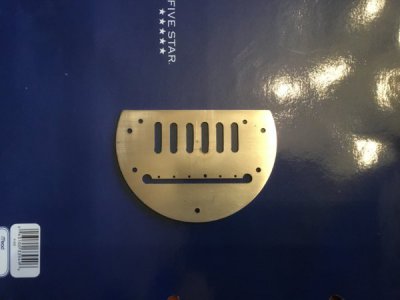Please disregard the less than perfect slots and a couple mistakes here and there in the attached part pictured.
Anyways, this part I started out as a 4.28" diameter circle with two holes to hold the piece down while turning. The bottom 1/8" hole is one of the hold-down holes. The other got cut off as the final piece isn't a full circle.
My approach to making this piece was to scribe in black sharpie all my guide lines and then eyeball my center drills over all places for holes.
I was thinking of another approach which incorporates using a mill more technically, like I imagine the big boys do.
I would first cut the piece as a square and then find the edge and then use the dial numbers to move the exact x.xxx" amount from one hole to the next. I figure that this approach requires me hitting the TurboCad drawing and taking many measurements from a given starting point, true?
On the mill though, my worry on this approach has to do with lead screw backlash,(correct term?) or play.
I'm figuring that every time I turn an axis knob in the reverse direction I will be off from my original 0/0 start, meaning that all those measurements I recorded down from the Turbocad drwing will not transpose well on the mill.
Is this a correct concern?
What method do you use for making a part like mine here?

Anyways, this part I started out as a 4.28" diameter circle with two holes to hold the piece down while turning. The bottom 1/8" hole is one of the hold-down holes. The other got cut off as the final piece isn't a full circle.
My approach to making this piece was to scribe in black sharpie all my guide lines and then eyeball my center drills over all places for holes.
I was thinking of another approach which incorporates using a mill more technically, like I imagine the big boys do.
I would first cut the piece as a square and then find the edge and then use the dial numbers to move the exact x.xxx" amount from one hole to the next. I figure that this approach requires me hitting the TurboCad drawing and taking many measurements from a given starting point, true?
On the mill though, my worry on this approach has to do with lead screw backlash,(correct term?) or play.
I'm figuring that every time I turn an axis knob in the reverse direction I will be off from my original 0/0 start, meaning that all those measurements I recorded down from the Turbocad drwing will not transpose well on the mill.
Is this a correct concern?
What method do you use for making a part like mine here?


 . Having said that, I have made lots of parts like that on a manual machine without a DRO, but I was machining long before DROs existed.
. Having said that, I have made lots of parts like that on a manual machine without a DRO, but I was machining long before DROs existed.